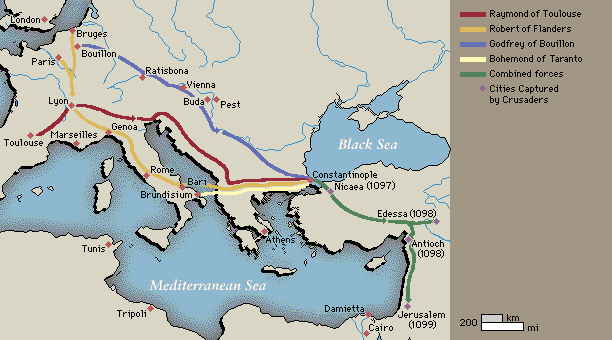Travel & Trade in the Crusades
Causes:
• To
ensure safety of pilgrims
• To
save
• To
get squabbling lords to focus aggression outward
• Idea
of actually freeing the

First Crusade:
• Called
by Pope Urban II during the Council of Clermont in 1095
• Offered
chance for the wealthy to get complete remission of sins
• Largest
Crusade, with 4,500 cavalry and 30,000 foot soldiers
• Majority
of travel went across land for this Crusade
• Soldiers
marched in a protective wall around cavalry to protect the valuable horses from
crossbows
• The
Crusaders met up in Anatolia, except for Godfrey of Bouillon, who met them in
• During
the siege of

Third Crusade:
•
•
• Ships
used were called “hulks” or “naves” which are large war
ships, and small “coasters,” which usually didn’t cross the
open sea
• Hulks
were often outfitted for war with rams, and turrets for soldiers to take refuge
behind and shoot crossbows
• Ship
to ship combat was rare, most sea attacks were from
pirates
• The
Third Crusade was not successful in taking the Holy Land, but the crusaders did
encounter many commodities like salt and silk which they brought back to


Fourth Crusade:
• Before
the Fourth Crusade, Christian boat-makers invented an inner skeleton for the
keel of sea going boats that allowed boats to be longer, deeper, and stronger. This paved the way for later
trans-Atlantic travel
• The
Pope recognized the need for a large fleet during the Fourth Crusade and sent the
crusaders to
• Dandolo, the doge of
• The
crusaders built up a large debt while waiting for their fleet to be built, and
the fleet was larger than needed. Dandolo then approached the crusaders and offered to cancel
their debt if they laid siege to Zara.
• While
in
• For wont of transportation and supplies, the Fourth Crusade disobeyed the Pope and became a crew of hired thugs.
This page compiled by Shannon Huecker for Professor Sterk's HIS 3931/REL 3938 course.